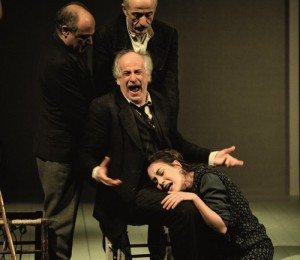You have no items in your cart. Want to get some nice things?
Go shopping
La grande bellezza, in which Toni Servillo glows as debonair writer Jep Gambardella, opens with a quotation from Louis-Ferdinand Céline: “Our journey is entirely imaginary. That is its strength.” The citation could just as easily describe Eduardo de Filippo’s 1948 play Le voci di dentro (Inner Voices), revived at the Barbican this week, in which Servillo is director and star. However, in evoking what Servillo calls “la difficoltà di orientamento in una realtà indistinta e compromessa”, Le voci di dentro uses a whole different toolkit to the films of Paolo Sorrentino. Not here will you find operatic crane shots and painstaking dollies, CGI flamingos and disappearing giraffes: the play’s visual vocabulary is stark, its doctrine metonymy rather than metaphor.
The set, by Lino Fiorito, is stripped to essentials: a whitewashed kitchen, consisting of little more than a cabinet, table and chairs. We are in impoverished post-war Naples, in the apartment of a large, eccentric family called the Cimmarutas; their playful teasing and eccentric personalities initially suggest we are comfortably in the cosy realm of farce. The Saporito brothers, Alberto and Carlo – played by Servillo and his real-life brother Peppe – live in the neighbouring apartment, where they run a scrappy furniture rental business. When they show up at the Cimmarutas’, it is apparently to scrounge for breakfast – but the real reason is much darker. Alberto is convinced that the Cimmarutas have murdered his friend, Aniello Amitrano; he knows where the body is hidden, he says, and possesses incriminating documents. He has called the police, and gleefully awaits their arrival: “Burn them alive!” he cries, like a tenement Torquemada. But when the police find no evidence and the Cimmarutas are released, he realises his mistake: the source of his accusations was nothing more than a vivid dream.
It is here that the play vaults into fantastic territory. Each member of the Cimmaruta clan comes to visit Alberto; far from upbraiding him, they believe that Alberto’s accusation has merit – and each Cimmaruta suspects the other of guilt. This begins a sinking spiral of suspicion and betrayal that soon claims Alberto himself, who becomes increasingly paranoid that Carlo will cheat him out of his inheritance – a fraught sibling relationship that de Filippo would later echo in 1955’s Bene mio e core mio. The soul of Le voci di dentro is the Saporitos’ uncle, zi’ Nicola, who has given up speaking because “the world is deaf”; instead, he communicates through letting off fireworks. That’s a suitable shorthand for the course of Le voci di dentro: what starts out as a family farce turns into a hypnagogic pinwheel of accusations, paranoia and death, discharging blistering sparks as it spins towards its fiery conclusion.
When Le voci di dentro had its last major London production – at the National Theatre in 1983, in what was Ralph Richardson’s final acting role – its English translation, by the nimble absurdist N.F. Simpson, was widely seen as neat but flat. The Barbican production sidesteps this difficuty by taking place in Italian with English surtitles displayed on monitors, restoring de Filippo’s trademark Neapolitan dialect. Nevertheless, what is most striking about Servillo’s production is not the language but the physicality. Servillo is wonderfully expressive, generating a Chaplinesque pathos in his Tramp-like baggy suit; he and his brother spark off each other, their heads often so close together that they resemble a two-headed dog. The 14-strong ensemble, meanwhile, use their bodies to full effect, displaying a mastery of the Italian gestural lexicon – a lexicon that, many academics believe, has its roots in Naples, perhaps as a way of getting attention in that overcrowded metropolis.
Alberto concludes that his dream had some element of truth: he was not so much hallucinating as listening to the inner voices of the title. Indeed, the play seems to support the Freudian tenet that dreams reveal: Alberto’s vision may have been a fiction, but it exposes the grasping, treacherous entrails of an Italian society reduced to moral rubble. Like La grande bellezza, or Servillo’s first Sorrentino collaboration L’uomo in più, Le voci di dentro takes place in a universe suspended between the imagined and the real. Which is which? As Jep Gambardella would say of la vita: “In fondo, è solo un trucco. Sì, è solo un trucco.”
Le voci di dentro (Inner Voices) continues at the Barbican until March 29. The Barbican also announced its new 2014-15 season, which includes an internationa Ibsen season and a production of Hamlet starring Benedict Cumberbatch. For more on the forthcoming season, see here.
Subscribe to Litro Lab via itunes RSS | More

About Daniel Marc Janes
Daniel joined Litro in July 2013. He has previously contributed to the LA Review of Books, Little White Lies, the London Review of Books blog and the New Statesman's Cultural Capital.





